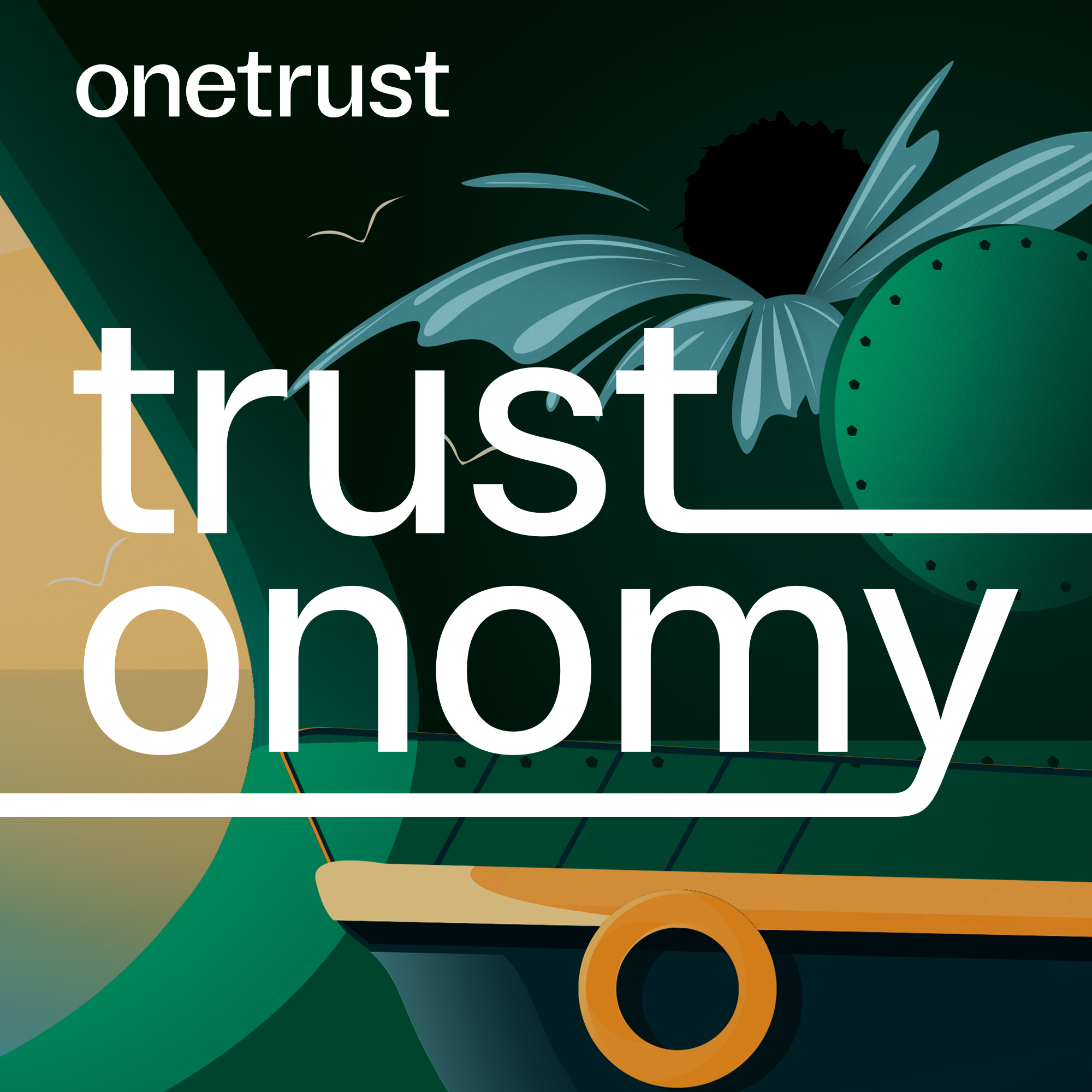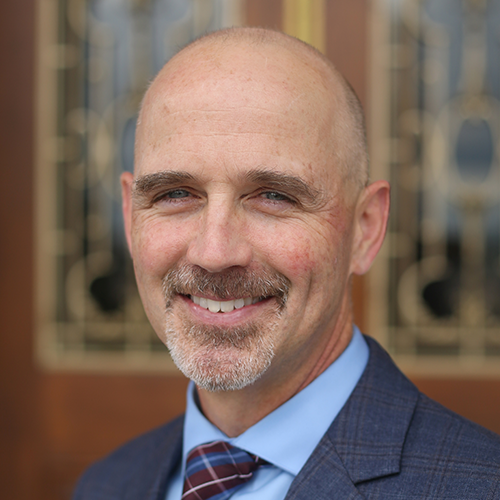Sep. 28, 2023
Episode 1: The safety shortcuts that sank a steamboat company

About this episode
In 1904, a fire broke out on a steamboat full of families enjoying a ride along New York City’s East River. The panicked passengers quickly discovered they had an even bigger problem on their hands - the ship’s life preservers. The safety equipment turned an emergency into a catastrophe.
We talk with Edward T. O’Donnell, author of Ship Ablaze: The Tragedy of the Steamboat General Slocum, and Matt Moog, General Manager of Third Party Risk Management at OneTrust, to find out how an untrustworthy vendor can sink your brand and your business.

Guest
Edward T. O'Donnell

Guest
Matt Moog
Edward T. O’Donnell is a history professor at Holy Cross College in Worcester, MA. He is the author of several books, including Ship Ablaze: The Tragedy of the Steamboat General Slocum. His writing has also appeared in the Washington Post, Newsweek, and the New York Times.
Matt Moog is the General Manager of Third Party Risk at OneTrust.
Shalene Gupta:
It is June 15th, 1904, and on the East River, just a short distance from Lower Manhattan, 1300 people are fighting for their lives because the steamboat they've been riding, the General Slocum, has just caught fire. One of the many mothers on board, Elizabeth Kircher, was desperate to save her daughter Elsie from the flames.
Edward T. O'Donnell:
She did not know how to swim, so they put a life preserver on her and as eyewitnesses said later, she sank as though a stone were tied to her. Accounts like that were very, very common in the aftermath. People dutifully put life preservers on themselves, on their children, and then jumped in the water and they never resurfaced.
Shalene Gupta:
When the Slocum burned and sank in the East River, more than 1,000 people died. It remained the single greatest disaster in New York's history until the attacks on September 11th, a century later. But things may have gone very differently that day. The river was busy and full of other boats that could have helped anybody who jumped overboard and was able to stay afloat. So how did it all go so terribly wrong, and why are we talking about this now? It all comes down to trust and the critical business practices that keep it afloat. I'm Shalene Gupta, and this is Trustonomy, an original podcast from OneTrust.
As an author and journalist, I've spent years learning how top CEOs and managers build great companies. I co-authored a book about them and along the way, there's one story that rang out louder than the rest. It's the story of trust. Trust is a superpower. Leaders who nurture it unleash innovation and creative problem solving. They create loyalty with customers, clients, and employees. Trust is directly connected to growth. Here on Trustonomy, each episode will start in the past with a story about broken trust that will make you rethink how you do business today, help you build and strengthen trust, and teach you how to repair it if it's been damaged. We'll talk to experts about issues like privacy, organizational culture and data management, and examine how each can impact trust.
Matt Moog:
I mean, trust is that fickle beast of it takes you years to gain it and an instant to break it, and that's always going to be the case.
Shalene Gupta:
This is Matt Moog. He's the expert who's going to help us figure out what a fire on a steamboat can teach us about assessing risk, and how the suppliers you do business with can sink your company. We will hear more from Matt later, but first we need to find out exactly what happened on the General Slocum. It all begins with a large group of German-American immigrants heading down to Manhattan's East Third Street pier.
Edward T. O'Donnell:
It's a gorgeous day, one of those spectacular June days where it's warm and sunny and the Slocum was there waiting for them at about 8:30 in the morning.
Shalene Gupta:
That's historian Edward T. O'Donnell. He's the author of Ship Ablaze: The Tragedy of the Steamboat General Slocum.
Edward T. O'Donnell:
It's a very impressive ship. It's 300 plus feet in length. It's got a great big paddle wheel. It's shimmering white. It was really the most impressive boat in all of the New York waterways.
Shalene Gupta:
There were more than 1300 passengers boarding the Slocum that day. They had chartered this grand steam powered paddle wheeler to take them to Long Island for their annual church picnic.
Edward T. O'Donnell:
They were all dressed in their Sunday finery, but people were also carrying picnic baskets and blankets and they're really full of excitement because this is the 17th annual version of this. So people know this is generally a pretty awesome day.
Shalene Gupta:
In 1904, the General Slocum is 13 years old, and it's run by the Knickerbocker Steamboat Company. We heard earlier about Elizabeth Kircher as she tried to save her daughter, but she was just one of hundreds of parents on the Slocum. Ed's research delved deeply into one family in particular, a husband and wife with three small children, the Liebenow's.
Edward T. O'Donnell:
The Liebenow's and the in-laws rush right up to the top deck, because for them that seems like the best place where you get a nice view and you're out in the open.
Shalene Gupta:
Other boats in the harbor toot their horns in recognition. A band plays the most popular German and American tunes of the day. Families are buying beer and pulling food from their picnic baskets. Passengers feel at ease, and they have good reason to. The General Slocum was an impressive vessel, and its captain, William H. Van Schaick, had been piloting boats for 50 years.
Edward T. O'Donnell:
He had gotten a gold medal from some seaman's organization the year before for his exemplary safety record, and the captain was highly regarded as one of the most experienced, trustworthy, safety-conscious captains in those waterways.
Shalene Gupta:
By 9:00 that morning, the ship casts off and begins chugging up the East River. On board, the party's already begun. That fun environment lasts for all of 12 minutes, and then...
Edward T. O'Donnell:
A crew member is informed by a young boy that there's smoke coming up a stairwell, and he goes to check it out and finds that smoke is coming out of a storage area. None of these folks have been trained in any kind of fire safety, so he just yanks open the door. The flames that are smoldering in some hay that has been used as packing material goes from smoldering to turning into actual open flame, and the deckhand tries to whack the fire out with a piece of tarpaulin, and then he just runs and he runs off to get some help, but he leaves the door open, and so the fire quickly engages everything else, and the room is full of flammables. It's called the lamp room, so it literally has lamp oil, oily rags, all that stuff.
Shalene Gupta:
The deckhand and the first mate run for the fire hose, but the hose is old and rotting. It ruptures in their hands.
Edward T. O'Donnell:
And they, again, because they're untrained, they just drop the hose and run. And so the fire spreads with astonishing speed up that stairwell and then in every direction so that by the time the captain is informed just a few minutes later, the ship is really very seriously compromised. There's a great big fire, and it's spreading everywhere.
Shalene Gupta:
Moments later, the passengers see smoke, big black coils of smoke. Cries of, "Fire, fire," start to carry across the ship.
Edward T. O'Donnell:
People just lost their minds. This is the most terrifying thing that anybody can imagine. Nobody knows how to swim. We're on a boat in the middle of the East River and the boat is on fire and the fire is raging in our direction.
Shalene Gupta:
I want to pause a moment on a crucial point Ed just made. Nobody knows how to swim. Keep in mind, public pools and swimming lessons were still uncommon in 1904. People didn't teach their children how to swim, so imagine the anxiety that's gripping Mr. and Mrs. Liebenow. Paul, the father, heads into the panicked crowds searching for the kids. Meanwhile, all around him, people are falling overboard in the chaos.
Edward T. O'Donnell:
There were many people who'd kind of got on the other side of the railing and kind of hung on, only to be swept overboard by groups of 20 and 30 people just rushing away from a burst of flame, right through a railing, right into the east river, carrying everybody with them. The floors begin to collapse, and so with one great thunderous sound, the decks collapse in on each other, taking with it scores and scores of people. People on shore and on boats are watching this unfold and they later tell journalists, so we have these vivid accounts of a great big ball of fire pouring out of the port side of the vessel and then eventually moving its way all the way to the back.
Shalene Gupta:
The fire is already a catastrophe, but the size of that catastrophe is about to balloon, and that's because of mistakes that were made months, even years, earlier.
Edward T. O'Donnell:
So boats of this size were required to have lifeboats, but these lifeboats, somebody on the Slocum at some point decided just to wire them in place so that they wouldn't rock back and forth. They were basically affixed to the deck of the ship and none of them were able to get into the water.
Shalene Gupta:
There's one hope left, one way to survive. If they could jump overboard and stay afloat long enough, one of the boats in the East River might save them. After all, it was a very busy waterway. The help would be there soon, but again, very few people on board can swim. So everything now depends on the life preservers.
Edward T. O'Donnell:
Everywhere the life preservers were found, you found clusters of people, and so that's where Paul Liebenow found him himself.
Shalene Gupta:
At the turn of the 20th century, life jackets were filled with cork. That's how they floated. So imagine Paul Liebenow's terror when he notices that the cork is spilling out of the life preservers. The canvas covers are falling apart and the cork itself seems to be crumbling. Regardless, Paul Liebenow grabs two life preservers for his family. Everybody on board is dropping these crumbling life preservers to their children and then lowering them, praying over the side of the vessel.
Edward T. O'Donnell:
Hoping that one of these boats that's trailing will pick them up. It turned out that many of these life preservers simply were almost like sacks of dirt. The cork had dissolved and broken up, lost all its buoyancy, and so instead of having a life preserver, you had a vest full of a substance that would absorb water and pull you down. The water around the Slocum was filled with cork dust and the people actually choked on it. Everything that could go wrong did go wrong.
Shalene Gupta:
Every second, more passengers are dying. In the end, more than 1000 people perish. Nearly everyone on board.
Edward T. O'Donnell:
Each family was affected differently. Some people lost a single family member, some families lost more than 10. When the funerals began a few days later, thousands of New Yorkers went down to the Lower East Side and just stood there quietly dropping flowers in front of these horse-drawn hearses, many of which were carrying children. So there's a real outpouring of emotional support and witness that takes place to this tragedy in its aftermath.
Shalene Gupta:
Among the dead were Paul Liebenow's two elder daughters. Miraculously though, he, his wife, and his six-month-old baby, Adella, survive.
Edward T. O'Donnell:
So his daughter was the youngest survivor. She lived to be 99 years old.
Shalene Gupta:
When Ed started working on his book about the Slocum, Adella was still alive. She told Ed about her family's tragedy and showed him her father's scrapbook full of press clippings he had collected about the fire.
Edward T. O'Donnell:
And she said to me in her wonderful way, I think it was his therapy, and he cut out articles about new safety standards for these life preservers and for fire hoses. So he really kept kind of an eye on the broader story as well.
Shalene Gupta:
Look through these old reports, and this much is clear. A lot of things went wrong on that sunny June day in 1904. The crew was untrained. The lifeboats couldn't be launched. And it turns out even the inspector from the Steamship Inspection Service who checked out the boat just a few weeks prior, missed all the warning signs.
Edward T. O'Donnell:
They were sent out to make these inspections, almost all of which were perfunctory, were just cursory looks at things. They would quickly walk around the boat, they'd check a few boxes on a form and then be on their way, and you would be cleared to operate your vessel for the year. The form that he filled out that said condition of life preservers, condition of fire hoses, all of these things, and everything he's just signed off on as an in good condition, in fine working order.
Shalene Gupta:
Nobody saw the danger. Why? Well, because nobody was really looking for it, and there was one thing that transformed this disaster into an unparalleled calamity, the company that supplied those faulty life preservers to the Knickerbocker. Here's Ed reading from the coroner's report.
Edward T. O'Donnell:
The coroner, he said, "I found today more life preservers. Or life killers, rather, with rotten canvas, coverings split and rotten granulated cork, half dribbled out of the place where good, honest, solid cork ought to have been. I found several life preservers that had been removed from bodies dragged from the bottom of the river. These were waterlogged."
Shalene Gupta:
And who was that vendor?
Edward T. O'Donnell:
Their name comes right out of a Dickensian title for their company. Kahnweiler's Never Sink Life Preservers.
Shalene Gupta:
The Kahnweiler Company had guaranteed their life preservers for 20 years. The life preservers onboard the Slocum were only 13 years old. So why did they fail so dramatically? Kahnweiler and Sons had sourced their cork from another company, Nonpareil Cork Works, and Nonpareil was cutting corners in the worst way possible.
Edward T. O'Donnell:
Well, the Kahnweiler company thought it was buying, let's say, six pounds of cork when in fact it was much less cork fraudulently weighed down by iron, and this was the kind of corner-cutting scamming that was very common in almost every realm of business in the late 19th and early 20th century, and that regulatory agencies are just beginning to grapple with.
Shalene Gupta:
If the Knickerbocker company had done their due diligence and sourced functional life preservers, this story would've had a very different ending.
Edward T. O'Donnell:
Had people had access to functioning life preservers, even if they didn't put them on properly, probably could have stayed afloat 2, 3, 4, 5 minutes, many of them would've had a much greater chance of being saved. So really, the life preservers are at the center of much of the death toll that occurs.
Shalene Gupta:
So what happened to the Knickerbocker Company in the aftermath of the fire? What responsibility did they bear? Captain William H. Van Schaick was sent to prison, and several directors of the Knickerbocker Company were indicted, but escaped conviction. The company itself dodged hefty legal penalties, but they couldn't escape punishment in the court of public opinion. Knickerbocker lost the trust of New Yorkers. Their reputation went down in flames. Just a few days after the Slocum tragedy, another one of their ships, the Grand Republic, was booked for a big trip.
Edward T. O'Donnell:
And given the reputation or the news that had come out about the General Slocum's condition and its lack of safety standards, untrained crew, a lot of people decided not to come, and so only about 25% of ticket holders showed up that day. The Knickerbocker Steamboat Company directors realized that they were in a lot of trouble, so they realized that the safest thing from the saving their own skin perspective was to sell the assets and walk away.
Shalene Gupta:
The Slocum disaster caused an irreparable breach of trust. The Knickerbocker company never recovered and was ultimately dissolved.
Matt Moog:
It's a crazy story. I've never heard it before, especially since I spent the last 20 years in New York. I was just shocked to hear that it happened, and we don't still talk about it. I mean, I think it's a really valuable story.
Shalene Gupta:
That's Matt Moog, general manager of third party risk at OneTrust. Matt's work is all about assessing relationships with outside vendors, contractors and partners. It's his job to identify weaknesses in a company's supply chain to help reduce risk.
Matt Moog:
Oh, I can't think of a single industry that wouldn't benefit from understanding risk better.
Shalene Gupta:
For Matt, the Slocum tragedy is an old but powerful example of a common misunderstanding about third party risk that still exists today. Your customer doesn't know or care about the other companies behind the scenes.
Matt Moog:
I'm sure there's not a single person that got on the Knickerbocker Steamboat Company's General Slocum and said, "Hey, I know who's actually providing the cork in these life vests, and I know who's providing the life vests themselves." I doubt anyone knew Kahnweiler and Sons until after the incident happened. Then they probably didn't care too much about Kahnweiler and Sons. They cared more about the Knickerbocker Steamboat Company because that was the company that was leading the boat. So therein lies the need to make sure that you're not just managing risk, but managing who you choose to do business with.
Shalene Gupta:
There's no way to completely avoid risk, but it helps if you allocate your resources to the most risky part of the business. Matt finds that most organizations spend 30 to 40 times more on managing internal risks when the external third or fourth or fifth party risks are much more dangerous.
Matt Moog:
We see a lot of organizations who don't really take the time to trace the data to another party, don't take the time to trace a dependency to another party, and then you have a failure by that fourth party or sometimes fifth party, and that ripples up through the chain and then you end up with an impact to your customer. So understanding that evolution of impact, both from a data perspective, a resiliency perspective, and just a core product standpoint, sometimes opens people's eyes to where risk may exist that they weren't aware of before.
Shalene Gupta:
For the Knickerbocker Company, those third party risks were as high as they come, but regardless of the level of risk you face in your business, Matt says you'll be much more successful if you don't confuse compliance or simply following the rules with true risk management.
Matt Moog:
I see compliance as going through the motions of what needs to be done and what's expected to be done. I think when you're in a compliance mindset, you're just focused on getting your job done. You're typically doing it with blinders. You don't really care about anything else around you. You're making sure that you've checked each box. It's a black and white type of an activity.
Shalene Gupta:
Remember the inspection officer who examined the General Slocum before its departure? That was a big red flag. The inspector, and by extension, the Knickerbocker Company, was treating third party risk management as a compliance issue. They didn't really think about mitigating risks for themselves or their customers in a proactive way.
Matt Moog:
Compliance would tell you to have a life vest for each person. Compliance would tell you that that life vest would need to be clearly marked. Compliance would tell you that life vests need to be located at certain portions of the boat and distributed throughout the boat.
Shalene Gupta:
But real risk management isn't black and white. It's a gray area that requires a healthy dose of skepticism.
Matt Moog:
We always ask ourselves in risk management what could happen. So in the Slocum story specifically, risk management would tell you, these life vests are 13 years old. Risk management would tell you, I threw a life vest in the water and it disintegrated. Unless you actually pressure test what's expected, you're never going to find if it works or not.
Shalene Gupta:
And you don't want to find out something's not working during an emergency.
Matt Moog:
You want to have that happen in a controlled situation, and I guarantee if they said, "Hey, five people, you need to go find your nearest life vest, put them in the water and make sure they float, and you got to do that every month or three months or six months," or whatever. That's kind of how you talk about risk management over time, is making sure that you've kind of lived through the scenario.
Shalene Gupta:
Plus, a real risk management approach would've uncovered not just the life preserver failure, but the dysfunctional hoses, the lack of fire training for the staff, the badly stored flammable materials, and the inaccessible lifeboats. Real risk management would've changed everything.
Matt Moog:
I don't know how many times that inspector may have inspected that boat, but you do that 10, 20, 30, 40 times, it becomes kind of routine and you don't really take the time to objectively look at something new.
Shalene Gupta:
When risk assessment becomes routine, you might miss important details. It can take a fresh perspective to see the entire picture. Nevertheless, you can't avoid risk completely, but it's important to know which risks are worth taking.
Matt Moog:
Not only understanding what could go wrong, but what my trade-offs? Am I paying a little bit more for higher quality? What's the risk relative to a fire in the boat? Should I be doing other things? Risk management requires you to ask those additional questions and to go down those additional paths to make sure that whatever decision you're making with the context of risk is the right decision for the company overarchingly.
Shalene Gupta:
Of course, third party risk management means more than just throwing a life preserver in the water. We have more tools to understand what trade-offs are worthwhile. We can research our vendors and see what kind of history they have. We can ask for referrals and look into their finances, especially if they are new relationships or providing new services. Third party risk management has an element of detective work to it, when done well.
Matt Moog:
It's not just the services that are directly being provided, but it's the overall company itself. If it's a company that's going to grow with you, understanding if they're financially viable, maybe they went for a recent debt round of funding, then there's the potential that they're cutting corners. They may be cutting their own costs.
Shalene Gupta:
It's also important to talk with other companies that have already used your prospective vendor. Did they have any issues with the vendor's product or service? With Kahnweiler and Sons, that background research might've revealed that their life preservers were less trustworthy than promised.
Matt Moog:
I think many people looked at it and said, "Well, there's a 20-year guarantee on it, so it's going to work." Well, 20 year guarantee isn't really that good when they just put the number 20 on a box and really didn't have anything to back it up with. So it's hard to stand by a guarantee like that if there's not a track record or a history of saying exactly when these things start to fail.
Shalene Gupta:
It is all about verifying on your customer's behalf rather than blindly trusting. You're doing that verification work so your customer can develop a bond, a lasting trust in everything you do.
Matt Moog:
If I had to guess, the Knickerbocker Steamboat Company may have been more concerned with cost, so they may have said, "Whoever I can get the most amount from in the shortest period of time for the least amount of cost, that's going to be good business." Well, it may be good business, but it's not good risk management. And I think there's a balance there to be had between what's good business and what's good risk management.
Shalene Gupta:
Learning to build risk management, especially third party risk management, into our idea of good business has been a long time coming. In the 19th century, a trust economy starts to emerge as people's lives and businesses start to become more interconnected. Whether it's riding a steamboat or flying on a 737 airliner, so much of what we do is predicated on trust. And when you break that trust, like the Knickerbocker Company did, you won't be able to blame your third party vendors.
Matt Moog:
We've seen significant issues where customer harm has been done or a breach has occurred, and the regulars do not allow you to pass those fines onto third parties. They make you absorb those holistically. You can't push that out to someone else and say, "Well, that was their fault."
Shalene Gupta:
And if the damage is severe...
Matt Moog:
It can destroy your entire brand. It could mean fines from a regulatory perspective. It could mean class action lawsuits from a customer perspective. It could mean bankruptcy, it could impact distributors, it could impact stores. It could impact brokers and agents. What you do with your company and your decision, especially with respect to customer trust, that ripples through every aspect of the organization and how it operates.
Shalene Gupta:
But at the end of the day, losing trust is always about more than a fine. It's about more than losing customers too. It's about the integrity of your business and your brand in the long term. And once it's damaged, well...
Matt Moog:
You have to earn that trust again, and that might not be a PR event that happens over the course of two weeks. That may be 10 years of repairing trust with your customers, and there's still no guarantee at the end of that that you're going to regain their trust.
Shalene Gupta:
It's an unfortunate reality that sometimes things go terribly wrong before they get better. The Knickerbocker Steamboat Company made fatal risk and trust decisions back in 1904, and while it's cold comfort for the families of those who drowned, the disaster did lead to new regulations for steamboats.
Edward T. O'Donnell:
Lots of recommendations come forward, and many of them are adopted. Things like putting sprinklers throughout a vessel, creating the ratio of one life preserver to each passenger, and then creating standards for those life preservers themselves. So there are a lot of positive things come out of the tragedy. They don't offset the tragedy, but the measures that are taken, many of them are quite meaningful, and to this very day are saving lives.
Shalene Gupta:
Today, over a century later, the world has become more complicated and more connected, with technology playing a greater role in our lives. The way we assess risk has certainly improved, but to truly create safety and trust, we have to get past that compliance mindset Matt mentioned, and investigate risk beyond some simple checklist. We also have to research vendors and all third parties in a meaningful way. And of course, we have to keep in mind those large financial and legal stakes that should inspire anyone to take third party risk management seriously. When we use third parties, sometimes we fool ourselves into thinking, "Hey, someone else is handling that," but in the end, it's your responsibility, because consequences are immediate and real to your customers. That's how real and important trust can be. Until next time, I'm Shalene Gupta, and this is Trustonomy, an original podcast from OneTrust.
You might also like

OneTrust Talks Tech
The OneTrust Talks Tech podcast is dedicated to providing listeners with weekly OneTrust product updates and information from industry experts on privacy, risk, compliance, ethics, and environmental topics.

